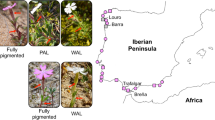Abstract
IN a letter published in NATURE of June 27, 1931, Miss Scott Moncrieff mentions an interesting case of flower-colour inheritance in Pelargonium. On selling, a rose-pink variety gave seventeen offspring like itself and three others producing salmon-pink flowers. The rose-pink petals contained the anthocyanin pigments, cyanin and pelargonin (the latter only as a trace); the salmon-pink petals, pelargonin only. That is, the dominant factor in colour inheritance causes cyanin to be formed almost entirely instead of pelargonin. This factor, therefore, as pointed out by Miss Scott Moncrieff, brings about the insertion of a hydroxyl group in the phenyl ring, which process may be regarded as one of oxidation.
Similar content being viewed by others
Author information
Authors and Affiliations
Rights and permissions
About this article
Cite this article
ONSLOW, M. Chemical Effect of a Mendelian Factor for Flower Colour. Nature 128, 373–374 (1931). https://doi.org/10.1038/128373b0
Issue Date:
DOI: https://doi.org/10.1038/128373b0
- Springer Nature Limited
This article is cited by
-
Theories of the biogenesis of flavonoid compounds (Part II)
The Botanical Review (1952)
-
The anthocyanin pigments of plants
The Botanical Review (1947)
-
Die genetischen Grundlagen der Blütenfarben
Zeitschrift für Induktive Abstammungs- und Vererbungslehre (1938)
-
Contributions to the genetics of the China aster
Genetica (1937)
-
A biochemical survey of some mendelian factors for flower colour
Journal of Genetics (1936)





